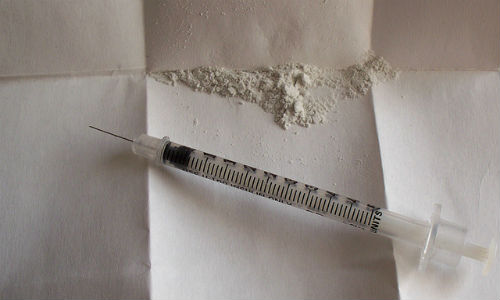President Barack Obama on Tuesday called for new approaches and more funding to help people addicted to heroin and prescription painkillers.
Speaking at a drug abuse summit in Atlanta, Obama said, “For too long we have viewed the problem of drug abuse generally in our society through the lens of the criminal justice system.”
Earlier this year, the Obama Administration asked Congress for $1.1 billion in new funding over two years to expand treatment for the epidemic. The Dept. of Health and Human Services also proposes new rules for buprenorphine, also known by the brand name Suboxone, a medication used to help those with substance abuse disorders reduce or quit opioid use. The proposal would allow physicians qualified to prescribe the medication to double their patient limit to 200 — expanding access to the life-saving medication to thousands of patients.
From 2000 to 2014 nearly half a million Americans died from drug overdoses — and the trend shows no sign of abating. Opioid overdose deaths, including from both opioid pain relievers and heroin, hit record levels in 2014, with a 14 percent increase in just one year, according to new data published in December 2015 in the Center for Disease Control’s Morbidity and Mortality Weekly report.
Increases in prescription painkillers and heroin deaths are the biggest driver of the drug overdose epidemic. Deaths from heroin increased in 2014, continuing a sharp rise that has seen heroin overdoses triple since 2010, CDC data showed. Deaths involving illicitly made fentanyl, a strong opioid often added to or sold as heroin, also are on the rise.
While reporters have liberally covered America’s drug epidemic, far less coverage exists on the medical treatment available to those struggling with addiction, and the business behind it. Each day, about 6,300 Americans seek some form of addiction treatment, according to the documentary film The Business of Recovery. In 2013, the drug rehabilitation industry generated over $34 billion in revenue, nearly four times the $9 billion in revenue the industry generated in 1986.
Unlike nursing homes, hospitals, and traditional rehabilitation centers, the drug rehabilitation industry is not firmly grounded in science, but is an outdated treatment system largely separate from traditional medicine, according to Dr. Mark Willenbring, an addiction psychiatrist who was featured in the HBO Addiction Project and has appeared on CNN, ABC, CBS, The New York Times, and many other media outlets.
Willenbring, who led a division at the National Institutes of Health responsible for funding research grants on alcohol treatment and recovery to U.S. universities, realized most the tools and knowledge from NIH research didn’t enter into the treatment of drug addicts. He currently runs a private practice, Alltyr, in St. Paul, Minnesota.
Willenbring and other industry leaders, including Dr. Lance Dodes, a psychiatrist and the former director of the substance abuse treatment unit of Harvard’s McLean Hospital, have sounded the alarm about the lack of alternatives to 12-step-based programs and the lack of evidence-based research behind those programs. Willenbring and Dodes say many of these programs are grounded in group therapy led by facilitators or “counselors” whose main qualification is their own completion of the program.
Willenbring told The New York Times, “When we publish studies in our field, nobody who is running these centers reads them. If it counters what they already know, they discount them,” he said. “In the addiction world, the knee-jerk response is typically, ‘We know what to do.’ And when that doesn’t work, we blame patients if they fail.”
In many states, drug counselors with only a high school degree may treat patients, according to a 2012 study by the National Center on Addiction and Substance Abuse at Columbia University.
While the traditional treatment for addiction usually includes a 28-day stay at an in-patient treatment facility based on the 12 steps, Anne Fletcher, the author of the 2013 expose of the treatment system, “Inside Rehab,” said no reliable evidence exists showing that intensive inpatient treatment works better than continual, outpatient care with physicians and psychologists certified to treat addiction. Many inpatient stays can cost upwards of $50,000 per month.
Given the lack of standardized regulations, the drug rehabilitation industry is ripe for local reporters looking for story ideas.
A good place to start: determine which regulatory agencies supervise drug treatment facilities in your state. What rules exist for professionals treating those struggling with addiction? How do those regulations differ from similar regulations that govern nursing homes, traditional rehabilitation facilities and hospitals? Do the differences make sense?
- Are criminal record checks performed on potential employees?
- Are references sought from prior employers?
- Is there an on-site psychiatrist, registered nurses and an on-site doctor?
- Do patients have regular access to these qualified individuals?
- How many nurses and aides are on duty during shifts?
- What are the qualifications (and wages) of technicians and aides?
- How much does the facility charge per day?
- What do patients receive in exchange for the fee?
- What is the turnover rate?
- Do patients receive individual counseling from master’s-level therapists?
- Does the facility help patients arrange after-care?
- Does the facility track their outcome rates? How is this information tracked? (Is it self-reported?)
- Does the facility pay counselors, therapists and doctors a kickback to refer patients to their treatment program?
- Does the treatment facility prescribe suboxone or methadone for patients addicted to opioids?
A great deal of information about local drug rehabilitation hospitals is available at the state-level. If the hospital accepts federal monies for Medicare and Medicaid patients, the state often helps monitor the facility. You can request violations and infractions and track deaths or any other serious events that have occurred at the facility.
Stephanie Innes, a reporter at the Arizona Daily Star, found that three patients had died in 13 months at an upscale drug treatment center north of Tucson. A fourth death occurred in August 2011. The facility costs about $1,300 per day. The facility was fined, but remains operating.
Another place to investigate is state court records. Do certain facilities have a pattern of repeated lawsuits? Sometimes lawsuits reveal other private facility records, including nursing schedules, salary information, board violations, etc.
Despite America’s increasing challenges with addiction, few medical schools have integrated training about addiction into their training. Few physicians are specifically trained about addiction and are certified to treat addiction, Kathryn Cates-Wessel, the executive director of the American Academy of Addiction Psychiatry told The New York Times.
As you do your reporting, ask what training is available to medical students in your area. Speak to some area physicians. Do they feel qualified to treat patients struggling with addiction?











